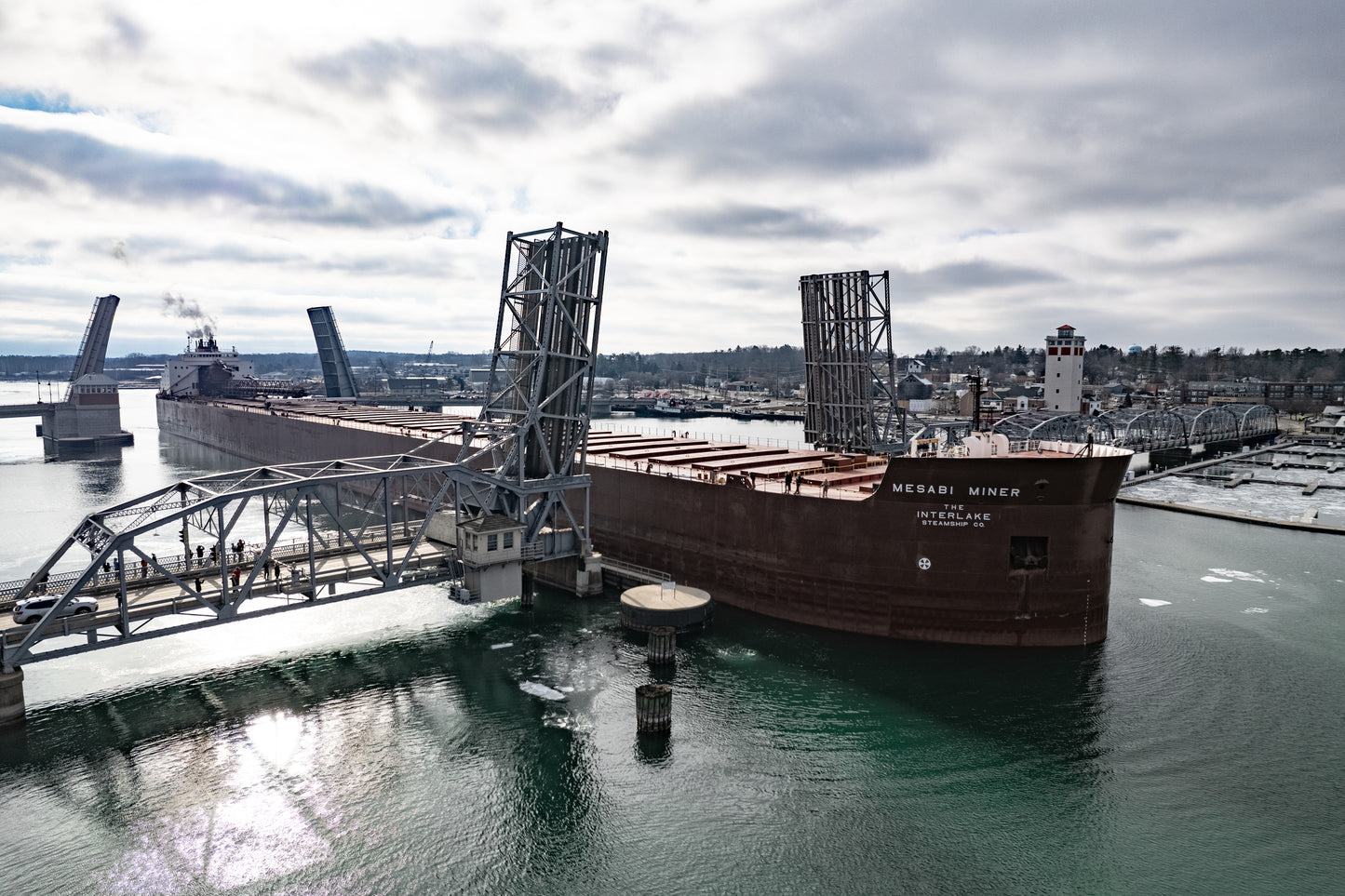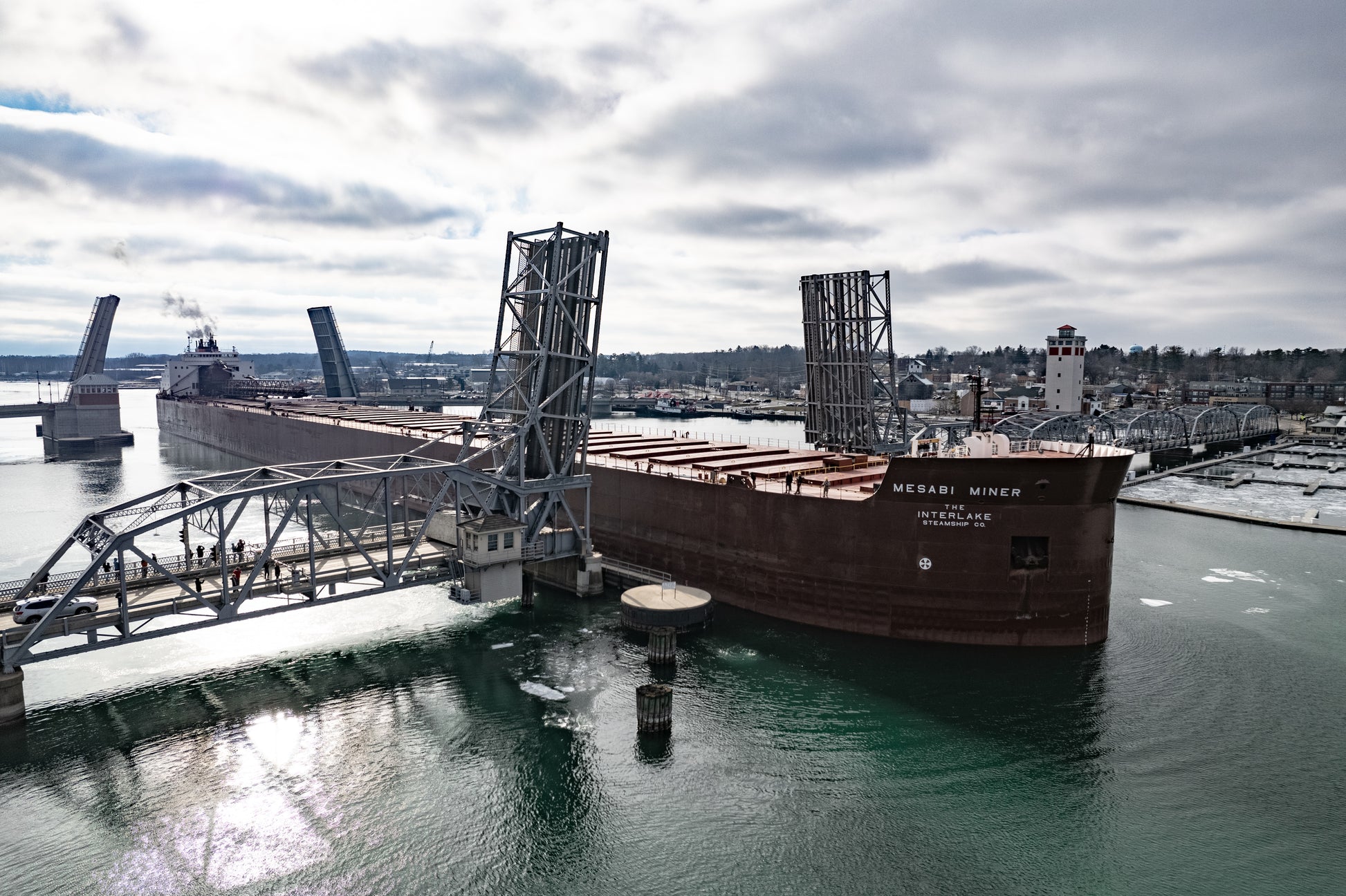Masabi Miner
Masabi Miner
Couldn't load pickup availability
The Mesabi Miner, a true giant of the Great Lakes, threads its way through the heart of Sturgeon Bay, a city built on maritime tradition. At 1,004 feet long, this behemoth of steel and cargo is part of the Interlake Steamship Company’s fleet, a vessel designed for the unrelenting demands of hauling iron ore, coal, and other bulk commodities across the inland seas. Launched in 1977 from the American Ship Building Company in Lorain, Ohio, the Miner was built with self-unloading capabilities, a design that allows it to offload its cargo in a matter of hours without the need for dockside assistance.
Beneath its massive steel hull, the Mesabi Miner is powered by twin 8,000-horsepower diesel engines, providing the strength to push thousands of tons of cargo through rough waters and narrow channels alike. Unlike many vessels of its size, the Miner possesses an advanced maneuvering system that allows it to move with precision—even in tight spaces—without the aid of tugboats. Equipped with both bow and stern thrusters, this freighter has exceptional control over its movement, able to pivot in place or make lateral adjustments as it approaches docks or navigates confined passages. The bow thruster, located near the forward section of the ship, helps push the vessel sideways, while the stern thruster at the rear provides additional agility. Combined with its dual engines, these features make the Mesabi Miner one of the most self-sufficient freighters on the Great Lakes, capable of executing complex maneuvers in harbors and canals where other ships might require external assistance.
Here, in Sturgeon Bay, the Miner faces one of its more intricate navigational challenges—passing through the city’s iconic bridges. The Michigan Street Bridge, built in 1931, was once the sole crossing over the Sturgeon Bay Ship Canal, a crucial passageway that allows vessels to bypass the treacherous waters of Death’s Door. But in 2008, the addition of the Oregon Street Bridge complicated the route for freighters of this size. As seen in this image, even with its bow already clearing the Michigan Street Bridge, a significant portion of the ship still lingers beyond the Oregon Street Bridge, showcasing just how immense these vessels truly are. The clearance is minimal, requiring expert coordination between the bridge operators and the crew to ensure safe passage without so much as a scrape against the steel spans. Despite the tight quarters, the Miner's powerful thrusters give it a level of independence rarely seen in a ship of this scale, allowing it to maneuver safely through these bottlenecks without the need for a guiding tug.
Behind the Miner, the Door County Maritime Museum stands as a tribute to the region’s deep connection to the Great Lakes shipping industry. Sturgeon Bay has long been a hub for shipbuilding and repair, and Bay Shipbuilding, located just beyond the frame of this image, plays a pivotal role in maintaining the working fleets of the Great Lakes. Each winter, freighters like the Mesabi Miner arrive in Sturgeon Bay for layup, undergoing vital repairs and inspections before setting out for another season. Bay Ship’s massive dry docks and skilled workforce make it one of the most essential shipyards on the inland seas, ensuring that vessels like the Miner remain seaworthy for decades.
For those watching from shore, the sight of a thousand-footer threading through the city is a moment of awe. Sturgeon Bay has developed a dedicated cult following of ship watchers, with hundreds gathering along the canal and bridges each time a freighter makes its passage. Some follow the vessels in person, staking out the best vantage points, while others track them through online ship-tracking services, anticipating each arrival and departure with excitement. Social media pages dedicated to ship-watching in Sturgeon Bay buzz with updates, photos, and live feeds, turning each freighter's movement into a community event.
It is a reminder of the scale of the shipping industry and the precision required to move these steel giants through such confined spaces. The Mesabi Miner, with its legacy of endurance and power, is more than just a ship—it is a symbol of the Great Lakes' working waters, where tradition and industry collide in a spectacle of movement, engineering, and sheer maritime force.
All prints are of museum quality and printed in The USA. Canvas Prints are wrapped around a hardwood frame to prevent long-term wrapping and utilize a 0.75" thick wrap. Metal Prints are glossy, vibrant, and of course are ready to hang. These prints make a statement and bring Door County home to your wall.
Share


